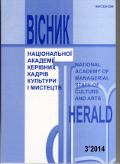COMPOSITIONAL TECHNIQUES THE GRAPHICAL REPRESENTATION OF THE ETHNICAL CONCEPTS
DOI:
https://doi.org/10.32461/2226-3209.3.2014.138115Keywords:
advertising and graphic products, design concepts, compositional organization of informationAbstract
This publication continues scientific research on design concepts, relevant graphic design, and conditions of their implementation in the promotional products. This article examines the implementation variability of the ethnical
concepts based on various iconic-symbolic elements and their groupings. The article gives the foundation for the
presence of typical composite groupings. It describes the conditions for a compositional organization of information
according to the ethnical concept.
It is proved that the designer’s project proposals are unable to encode the content accurately in case they do not have a clearly defined vector style. Thus, the implemented projects do not apply visual methods nor clarify the content, but cover the content up.
The article demonstrates that the letter font, symbol and sign elements are the most condactive for the visual embodiment of ethnically oriented design concepts. Because of them, a significant number of imaginative, emotional and contextual material is transformed into a set of stereotypes about certain ethnic culture. The combined effect of these elements can increase due to compliance with the conditions of the composite representation of information codes or decrease due to the neglection of the established compositional patterns. Each code represents well organized, and to some extent typical compositional scheme. This is an equal pointer ethnic oriented media, as well as signs, letters and symbols within this scheme.
For Ukrainian ethnical concept the main features for of the compositional organization of information are
fundamentality, concordance, symbolism, subordination.
Fundamentality. It is the selection of resistant composite connections between different elements or their stable
groups distributed within a culture that are not compatible with infinite variation of their combinations, but are the subjects to the traditions of visual coding. .
Concordance. It is an interaction of ethnic characters or visually stylized images without keeping precision scale,
rhythm, contrast, nuance. These characters partially ordered or they are based on repeated changes of ordering. (at the background area, or within the main semantic forms). This compositional method imposes restrictions on the "creative space" in relation to quantitative and qualitative composition as separate elements, as well as composite their groups involved in it.
Symbolism. It is an emphasis on the original form symbolism that was realized because of the accuracy and pithiness of graphical implementation of the essential qualities. These qualities have to be transmitted by visual
channels. The compositive group based on retention of this technique, focuses on meaningful fillings for one of the
encoding means (signs, symbols or letters font) or it secretes the opposition or merge of several images based on the
same mean, in such a way that a new formation would get a consistancy of interpretation.
Subordination. This is subordination and coordination of shapes, sizes, and related plastic changes between
stylized, formalized textual and emblematic elements of the visual message. Because of subordination relationships
between elements of visual get credibility and solid outline information notice get consistency.
Downloads
Published
Issue
Section
License
Authors who publish with this journal agree to the following terms:
1. Authors retain copyright and grant the journal right of first publication with the work simultaneously licensed under a Creative Commons Attribution License International CC-BY that allows others to share the work with an acknowledgement of the work's authorship and initial publication in this journal.
2. Authors are able to enter into separate, additional contractual arrangements for the non-exclusive distribution of the journal's published version of the work (e.g., post it to an institutional repository or publish it in a book), with an acknowledgement of its initial publication in this journal.
3. Authors are permitted and encouraged to post their work online (e.g., in institutional repositories or on their website) prior to and during the submission process, as it can lead to productive exchanges, as well as earlier and greater citation of published work (See The Effect of Open Access).


